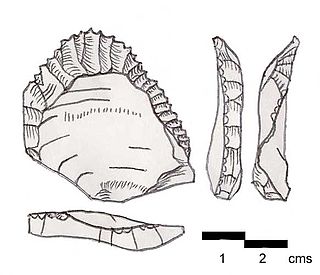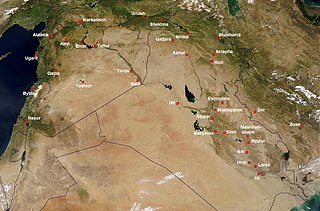
The Aurignacian is an archaeological industry of the Upper Paleolithic associated with Early European modern humans (EEMH) lasting from 43,000 to 26,000 years ago. The Upper Paleolithic developed in Europe some time after the Levant, where the Emiran period and the Ahmarian period form the first periods of the Upper Paleolithic, corresponding to the first stages of the expansion of Homo sapiens out of Africa. They then migrated to Europe and created the first European culture of modern humans, the Aurignacian.

The Upper Paleolithic is the third and last subdivision of the Paleolithic or Old Stone Age. Very broadly, it dates to between 50,000 and 12,000 years ago, according to some theories coinciding with the appearance of behavioral modernity in early modern humans. It is followed by the Mesolithic.

The Bacho Kiro cave is situated 5 km (3.1 mi) west of the town Dryanovo, Bulgaria, only 300 m (980 ft) away from the Dryanovo Monastery. It is embedded in the canyons of the Andaka and Dryanovo River. It was opened in 1890 and the first recreational visitors entered the cave in 1938, two years before it was renamed in honor of Bulgarian National Revival leader, teacher and revolutionary Bacho Kiro. The cave is a four-storey labyrinth of galleries and corridors with a total length of 3,600 m (11,800 ft), 700 m (2,300 ft) of which are maintained for public access and equipped with electrical lights since 1964. An underground river has over time carved out the many galleries that contain countless stalactone, stalactite, and stalagmite speleothem formations of great beauty. Galleries and caverns of a 1,200 m (3,900 ft) long section have been musingly named as a popular description of this fairy-tale underground world. The formations succession: Bacho Kiro’s Throne, The Dwarfs, The Sleeping Princess, The Throne Hall, The Reception Hall, The Haidouti Meeting-Ground, The Fountain and the Sacrificial Altar.
Tianyuan man are the remains of one of the earliest modern humans to inhabit East Asia. In 2007, researchers found 34 bone fragments belonging to a single individual at the Tianyuan Cave near Beijing, China. Radiocarbon dating shows the bones to be between 42,000 and 39,000 years old, which may be slightly younger than the only other finds of bones of a similar age at the Niah Caves in Sarawak on the South-east Asian island of Borneo.
Paleolithic Europe, or Old Stone Age Europe, encompasses the Paleolithic or Old Stone Age in Europe from the arrival of the first archaic humans, about 1.4 million years ago until the beginning of the Mesolithic around 10,000 years ago. This period thus covers over 99% of the total human presence on the European continent. The early arrival and disappearance of Homo erectus and Homo heidelbergensis, the appearance, complete evolution and eventual demise of Homo neanderthalensis and the immigration and successful settlement of Homo sapiens all have taken place during the European Paleolithic.

Ksar Akil is an archeological site 10 km (6.2 mi) northeast of Beirut in Lebanon. It is located about 800 m (2,600 ft) west of Antelias spring on the north bank of the northern tributary of the Wadi Antelias. It is a large rock shelter below a steep limestone cliff.
In the context of the recent African origin of modern humans, the Southern Dispersal scenario refers to the early migration along the southern coast of Asia, from the Arabian Peninsula via Persia and India to Southeast Asia and Oceania. Alternative names include the "southern coastal route" or "rapid coastal settlement", with later descendants of those migrations eventually colonizing the rest of Eastern Eurasia, the remainder of Oceania, and the Americas.

Kozarnika or Peshtera Kozarnika is a cave in northwestern Bulgaria that was used as a hunters’ shelter as early as the Lower Paleolithic. It marks an older route of early human migration from Africa to Europe via the Balkans, prior to the other currently suggested route - the one across Gibraltar. The cave probably keeps the earliest evidence of human symbolic behaviour and the earliest European Gravette flint assemblages came to light here.

The Levantine corridor is the relatively narrow strip in Western Asia, between the Mediterranean Sea to the northwest and deserts to the southeast, which connects Africa to Eurasia. This corridor is a land route of migrations of animals between Eurasia and Africa. In particular, it is believed that early hominins spread from Africa to Eurasia via the Levantine corridor and Horn of Africa. The corridor is named after the Levant.

Ust'-Ishim man is the term given to the 45,000-year-old remains of one of the early modern humans to inhabit western Siberia. The fossil is notable in that it had intact DNA which permitted the complete sequencing of its genome, one of the oldest modern human genomes to be so decoded.

Afontova Gora is a Late Upper Paleolithic and Mesolithic Siberian complex of archaeological sites located on the left bank of the Yenisey River near the city of Krasnoyarsk, Russia. Afontova Gora has cultural and genetic links to the people from Mal'ta–Buret'. The complex was first excavated in 1884 by Ivan Savenkov.

In archaeogenetics, the term Ancient North Eurasian (ANE) is the name given to an ancestral component that represents the lineage of the people of the Mal'ta–Buret' culture and populations closely related to them, such as the Upper Paleolithic individuals from Afontova Gora in Siberia. Genetic studies also revealed that the ANE are closely related to the remains of the preceding Yana culture, which were named Ancient North Siberians (ANS). Ancient North Eurasians are predominantly of West Eurasian ancestry who arrived in Siberia via the "northern route", but also derive a significant amount of their ancestry from an East Eurasian source, having arrived to Siberia via the "southern route".
The Ahmarian culture was a Paleolithic archeological industry in the Levant dated at 46,000–42,000 years before present (BP) and thought to be related to Levantine Emiran and younger European Aurignacian cultures.

The Bohunician industry was a paleolithic archeological industry in South-Central and Eastern Europe. The artifacts assigned to this culture are dated between roughly 48,000 and 40,000 years ago. They were found at the type site of Brno-Bohunice, Stránská skála (Moravia), Bacho Kiro and Temnata Cave (Bulgaria), Dzierzyslaw (Poland), and others.

The Uluzzian Culture is a transitional archaeological culture between the Middle Paleolithic and the Upper Paleolithic, found in Italy and Greece.
The Yana Rhinoceros Horn Site is an Upper Palaeolithic archaeological site located near the lower Yana River in northeastern Siberia, Russia, north of the Arctic Circle in the far west of Beringia. It was discovered in 2001, after thawing and erosion exposed animal bones and artifacts. The site features a well-preserved cultural layer due to the cold conditions, and includes hundreds of animal bones and ivory pieces as well as numerous artifacts, which are indicative of sustained settlement and a relatively high level of technological development. With an estimated age of around 32,000 calibrated years before present, the site provides the earliest archaeological evidence for human settlement in this region, or anywhere north of the Arctic Circle, where people survived extreme conditions and hunted a wide range of fauna before the onset of the Last Glacial Maximum. The Yana site is perhaps the earliest unambiguous evidence of mammoth hunting by humans.

Tongtiandong is an archaeological site in the Xinjiang Autonomous Region of China, just to the south of the Altai Mountains. The site had hunter-foraging human activity circa 40,000 BP.

The Zlatý kůň woman is the fossil of an ancient woman, an Early European modern human, dated to around 43,000 years ago. She was discovered in the Koněprusy Caves in the Czech Republic in 1950.

The Initial Upper Paleolithic covers the first stage of the Upper Paleolithic, during which modern human populations expanded throughout Eurasia.
The term Ancient East Eurasian, alternatively also known as East Eurasian or Eastern Eurasian, is used in population genomics to describe the genetic ancestry and phylogenetic relationship of diverse populations primarily living in the Asia-Pacific region, belonging to the "Eastern Eurasian clade" of human genetic diversity, and which can be associated with the Initial Upper Paleolithic (IUP) wave, following the Out of Africa migration (>60kya).

















